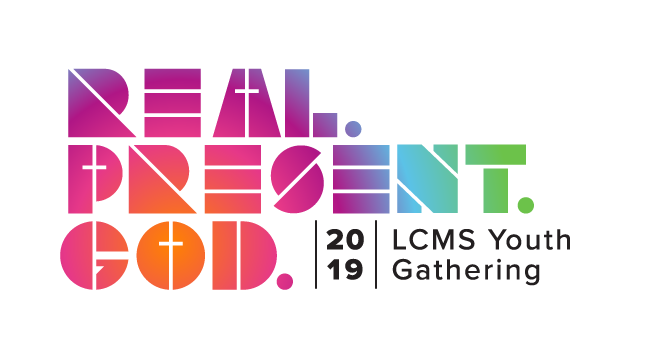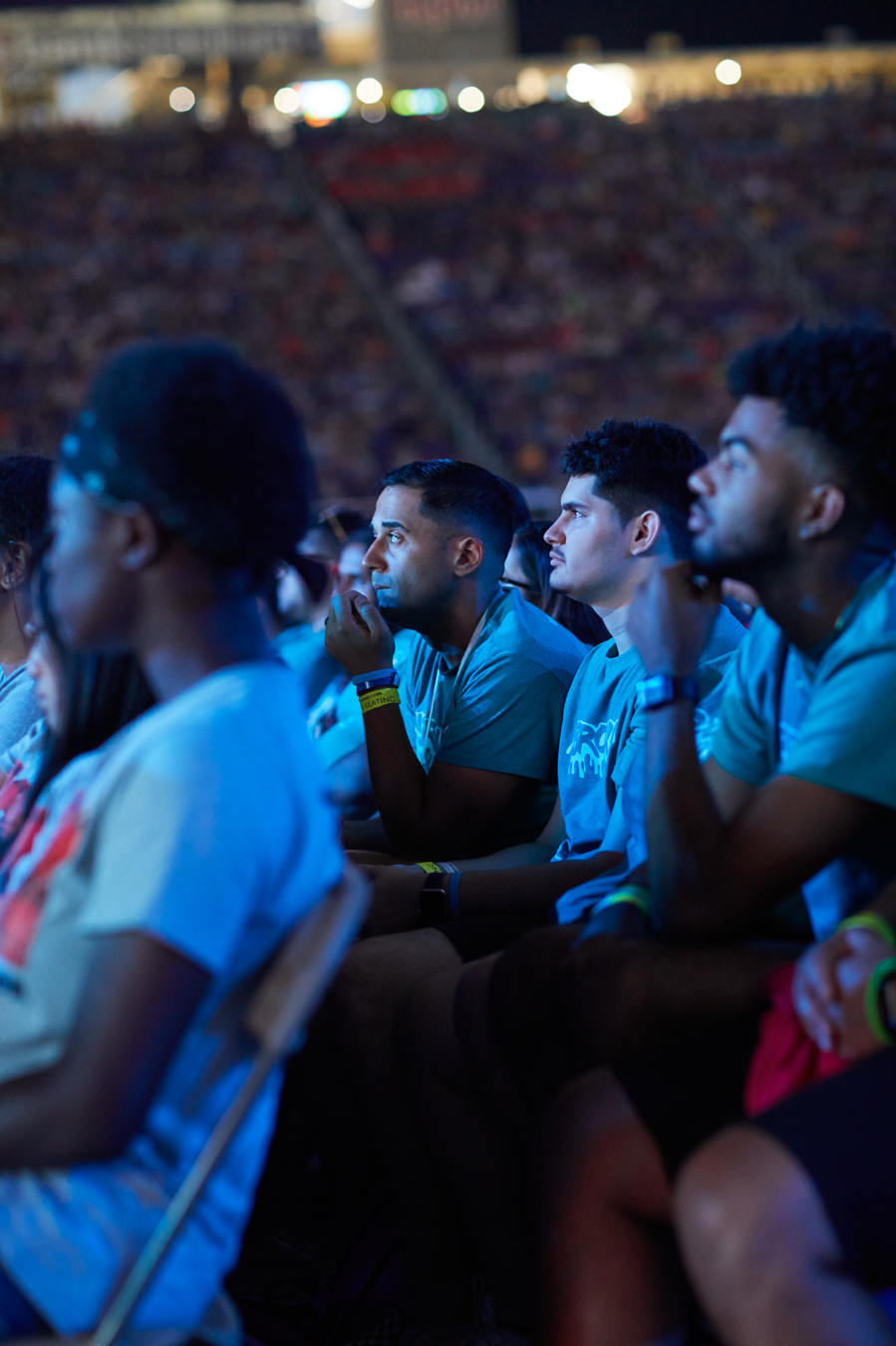
“You are real. You are present. You are God.”
I can still hear the stadium full of young Lutherans singing these words at the top of their lungs. It was a vigorous and unified confession of faith. A song of praise and honor to Jesus. To call it encouraging would be an understatement.
It took place at the LCMS Youth Gathering in Minneapolis this summer, and it stands in sharp contrast to statistics I’ve been hearing about young people in the church today. The number of youth in American churches in general, and in LCMS congregations in particular, is declining drastically. Many know this anecdotally firsthand. Some synodical stats confirm it. In 1970, LCMS congregations baptized 66,704 babies. Thirteen years later we confirmed 59,607. That’s almost 90% retention from baptism to confirmation. Fast forward thirty years. In 2000 we baptized 38,957 babies. (That, in itself, is striking, especially since US births increased during the same period from 3.7 million in 1970 to 3.9 million in 2000.) But this next number is absolutely startling. Thirteen years after baptizing 38,957 babies in 2000, we confirmed 18,454 young people. That’s 47%. You read that right. More than half the children we baptized in 2000 were gone before confirming their faith.[1]
Those numbers are alarming. And convicting. We can (and should) discuss the causes. We can (and should) do better. This requires a hard look at how society is changing, and how we are (or are not) responding to those changes.
As we do so, we should be encouraged by what happened in Minneapolis this summer. Which is one of the reasons I’m writing this post. I want to commend the leadership of our LCMS Youth Ministry Office and the many volunteers—professional church workers and lay volunteers—who gave an incredible amount of time and energy to provide this service to the church.[2] I’m also writing to give a glimpse into the substance of what was taught at this Gathering for those who did not attend.[3] Finally, I’d like to encourage us to talk more openly and honestly about how we better retain and equip young Christians today.
Real. Present. God.
The theme for the Gathering was “Real. Present. God.” It was based on the Psalms. The theme was drawn from Psalm 46,[4] with special attention to verse one: “God is our refuge and strength; a very present help in trouble.”[5] I won’t recap the entire event here. This video does that well. Instead, I’ll share a few thoughts about the three main sub-themes and how they were unpacked.
Real.
More than any other Youth Gathering I’ve been part of, this Gathering was real. That is, it was honest. It was honest about the challenges and questions young people face these days, refusing to whitewash them with platitudes and clichés. Frederick Buechner says preachers are tempted to deal only with the problems to which there are neat and easy solutions.[6] Some problems, however, are too complex to solve in this life. Forgiveness and new life are ours through faith in Jesus, but full resolution and restoration will occur only at his return. The Gathering was honest about this. The mess of life in this broken world is real. Equally real, however, is God and his promises. The Gathering didn’t try to prove that God is real. Rather, it proclaimed the reality of the Creator who has become part of his creation. It proclaimed the good news that in Jesus, God has come to restore. Because God is real with us, we can be honest with him about our sin, our hurts, and our questions.
Present.
God’s presence is much misunderstood in our pluralistic and syncretistic culture. It is also a two-edged sword. For those who belong to him, his presence is immeasurable strength and joy. For those opposed to him, it is judgment and dread. The Gathering emphasized God’s presence through his Word. It was spoken at creation and proclaimed by the prophets. It was preached by the apostles and took written form in the Scriptures. It continues in the celebration of the sacraments, in preaching, and in the mutual conversation of the brothers and sisters. God’s presence through his Word is most clearly and definitively seen in the Word made flesh. The Gathering focused attention throughout the five days on God’s gracious presence in Jesus. This is a local presence. Jesus is found wherever God’s people gather around his promises. As they do so, the community of the faithful becomes a refuge. God makes himself graciously present among his people as they speak his Word and as they live selflessly toward each other and their neighbor.
God.
Sometimes we encounter things that make us stop in our tracks. We can’t help but freeze and shut our mouths. “Be still and know that I am God.” Read in context, this verse doesn’t really belong on a pillow. (Sorry Hallmark.) It’s a call to cease and desist. To stop whatever we are doing and stand in awe before the Lord who reigns over all creation. Psalm 46 reminds us that God is all powerful, beyond all comprehension. But he is also up close and personal, intimately involved in each of our lives. (The youth appreciated Carl’s contribution to this point, which has since gone viral.) This God, who reigns over all and cares deeply for each of us, will return on the last day to raise us and all believers in a final victory over death. In the meantime, we let God be God. We allow him to suffer, and we suffer with him. We take comfort in his resurrection, and we rise in his Spirit. We fear him as Lord of all, and we love and trust his promises to us. We take seriously the urgency of the mission he has given us, and we dedicate our lives toward sharing the good news of Jesus so that all might believe and have life in his name.
The Gathering and Local Ministry
The LCMS Youth Gathering is not intended to be a single event, detached from local congregations and districts. Rather, it aims to support and propel the church’s day-to-day ministry to and through young people. To that end, the Youth Ministry Office is offering free Bible study resources for congregations and districts to use throughout the year. I encourage you to check them out and use them.
Earlier I said that we can do better equipping and retaining young Christians. The Gathering provides a promising model. We, as a church, could learn a lot from these four things that the Gathering does very well:
- Professional church workers (from every rostered office) need to work together with and learn from “normal” (lay) Christians.[7] From the earliest stages of planning, the Gathering is a partnership between members of the priesthood of all believers and ordained and commissioned ministers. In vocationally appropriate ways, each does their unique and invaluable part.
- We need to speak honestly and directly to our young people about the challenges and complexities of life. They are growing up in a rapidly changing world. They face questions and temptations that we could never have expected, and they will face more in the coming years that we cannot yet imagine. At such times, platitudes and clichés will not do. We need more substantive teaching, more intentional listening to young people, and a willingness to walk alongside those who are struggling.
- We need to expand our imagination of what faithful ministry can look like. Robert Hughes and Robert Kysar suggest this involves “re-languaging” and “re-imaging” tradition.[8] That’s good. But listen carefully. I don’t mean rejecting traditions. Neither do I mean repristinating them. We need to renew our traditions and our language in contextually appropriate ways. (For example, a two-year classroom style confirmation program finishing at 8th grade worked well in 1950. It does not work nearly as well today.) To revisit and renew our traditions faithfully, we need to work together closely. This involves holding each other accountable for being faithful to the Scriptures and the Confessions and for engaging the culture in meaningful ways.
- We need to direct all attention to Jesus and his promises. We should talk about Jesus more than anything else. And everything we do (and debate) should lead toward the proclamation of his promises. The Gathering centered around the crucified, risen, and returning Lord. It proclaimed God’s promises in Christ, which elicited that vigorous and unified confession of faith. That’s how it always works. That’s what it looks like to be confessional.
“You are real. You are present. You are God.”
I can still hear the stadium full of young people singing. May their tribe increase.
Endnotes
[1] Thanks to Rev. Mark Kiessling, Director of Youth Ministry for the LCMS, for gathering and sharing these statistics. For reference, participants at the Gathering numbered 21,000 (without counting close to 2,000 planners, volunteers, and speakers).
[2] The Gathering is a prime example of professional church workers and lay Christians working well together. The 1,300+ planners included DCEs, DCOs, Commissioned Teachers, Directors of Parish Music, Deaconesses, Pastors, and lay volunteers. It also involved people from all of the Concordia University System schools, both seminaries, representatives from all 35 districts, and 49 states. It is no surprise that the Gathering has had such an impact over the last four decades.
[3] Full disclosure: I served on the planning team and helped guide some of the content and programing.
[4] The hyperlink takes you to the opening signal for each Morning Session and Mass Event. By the end of the Gathering, the entire stadium was proclaiming “Real! Present! God!” with the man in the video as he recited Psalm 46.
[5] Over the course of the Gathering, participants learned this verse in American Sign Language.
[6] Buechner, Frederick. Telling the Truth: The Gospel as Comedy, Tragedy, and Fairy Tale (Harper and Row, 1977), 34.
[7] 80% of all adult chaperones at the Gathering are lay volunteers. This makes the Youth Gathering an important training ground for congregational leaders. The organizers of the event know this, which is why they offered substantial training sessions for adult leaders.
[8] Hughes, Robert G. and Robert Kysar. Preaching Doctrine for the 21st Century (Fortress Press, 2009), 29.


Leave a Reply
You must be logged in to post a comment.